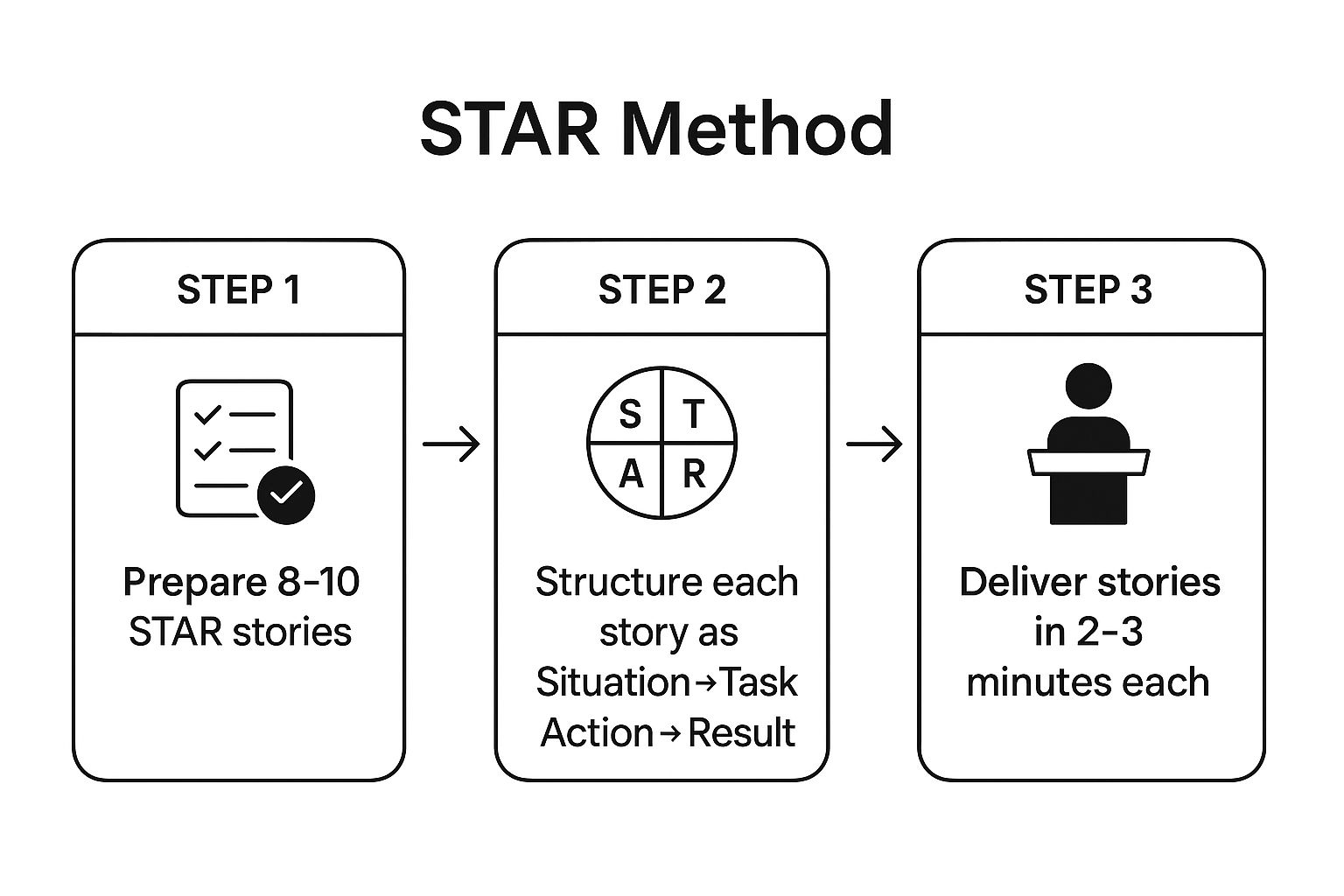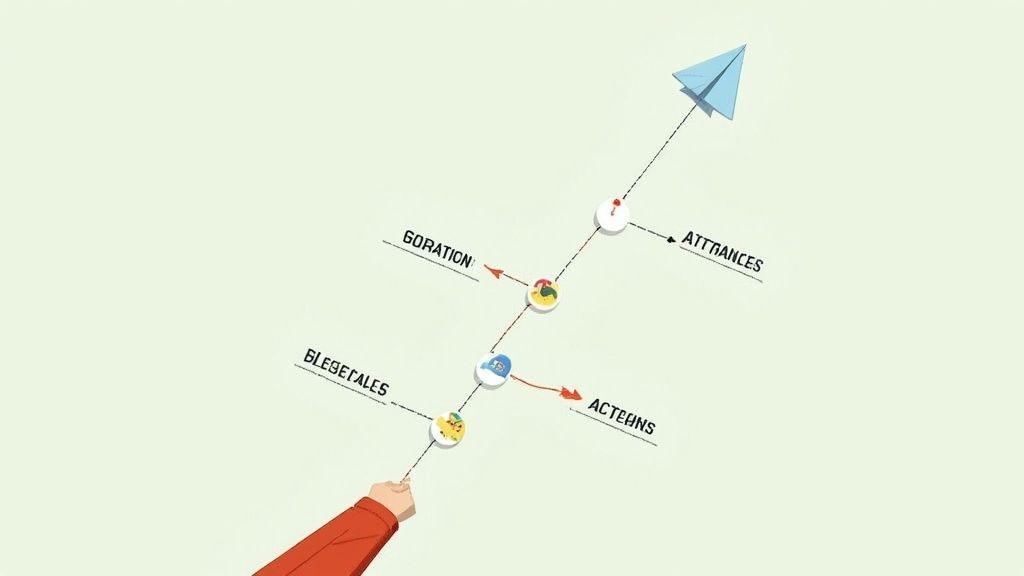
8 Frameworks With Answers to Hard Interview Questions (2025)
Published
Walking into an influencer marketing interview can feel like stepping into the spotlight. The questions are sharp, the expectations are high, and the competition is fierce. You're asked to prove your strategic mind, creative flair, and analytical prowess all at once. Standard advice often falls short, leaving you with generic responses that fail to impress. This guide is different. We're moving beyond clichés to provide a deep dive into the most challenging questions and, more importantly, a structured approach to crafting compelling answers to hard interview questions.
Forget memorizing scripts; we'll equip you with 8 powerful frameworks—from the classic STAR method to the concise PREP model—that enable you to structure your experience into memorable, impactful stories. You will learn not just what to say, but how to say it, turning nerve-wracking questions into opportunities to showcase your unique value. Mastering these techniques will give you the confidence to navigate any interview conversation and land your next role.
Beyond mastering these frameworks, a physical approach can also help manage pre-interview jitters; consider techniques like power poses to boost confidence right before you log on or walk in. This guide will break down each response method with specific examples tailored to the industry, ensuring you're prepared for anything.
1. How to Answer Behavioral Questions with the STAR Method
Behavioral questions, which often start with "Tell me about a time when...", are a cornerstone of modern interviewing. They are designed to evaluate your past performance as an indicator of future success. The STAR method is the universally acclaimed framework for structuring your answers to these questions, providing clear, concrete evidence of your competencies.
The acronym stands for Situation, Task, Action, and Result. This structure prevents you from giving vague or rambling answers. Instead, it guides you to present a concise, compelling narrative that functions as a mini-case study, showcasing your skills in a real-world context. This is one of the most crucial tools for providing excellent answers to hard interview questions.
How to Implement the STAR Method
Mastering this technique requires preparation and practice. The goal is to have a library of stories ready to adapt to various questions.
- Situation: Briefly set the scene and provide necessary context. What was the challenge or project?
- Task: Describe your specific responsibility or the goal you were tasked with. What needed to be accomplished?
- Action: Detail the specific steps you took to address the task. This is the most important part; focus on your individual contributions, not the team's. Use "I" statements.
- Result: Conclude by explaining the outcome of your actions. Whenever possible, quantify your results with metrics like a 15% increase in engagement or a 10% reduction in campaign costs.
The infographic below outlines a simple, three-step process for preparing and delivering your STAR stories effectively.

This visual process emphasizes that success with the STAR method hinges on proactive preparation and disciplined, time-bound delivery during the interview.
2. The CAR Method: A Streamlined Alternative for Impact
For interview questions demanding a focus on problem-solving and impact, the CAR method offers a more direct and punchy alternative to STAR. It streamlines the narrative by concentrating on the core elements of a professional challenge, making it a powerful tool for delivering concise answers to hard interview questions, particularly in fast-paced interview settings.
The acronym stands for Challenge, Action, and Result. This framework is favored in environments like consulting and high-growth startups where demonstrating resilience and a solution-oriented mindset is paramount. By omitting the detailed "Situation" and "Task" of STAR, CAR allows you to get straight to the heart of the problem and your role in solving it, highlighting your ability to perform under pressure.
How to Implement the CAR Method
The strength of the CAR method lies in its brevity and focus. It’s ideal for demonstrating your analytical and problem-solving skills quickly and effectively.
- Challenge: Start by defining the specific problem or difficult situation you faced. What was the core obstacle or business issue?
- Action: Describe the specific, high-impact steps you took to address the challenge. This is where you prove your capability, so use strong "I" statements and focus on your direct contributions.
- Result: Conclude by clearly stating the positive outcome. Quantify this result with concrete data whenever possible, such as "secured a partnership that increased reach by 25%" or "resolved a brand crisis, preventing a 40% drop in social media sentiment."
This approach is highly effective for roles in project management, sales, or any position where overcoming significant hurdles is a key responsibility. It frames your experience through a lens of challenge and resolution, which is highly valued by recruiters in these fields.
3. SOAR Method
While the STAR method is excellent, the SOAR method offers a powerful alternative that specifically emphasizes overcoming challenges. It is particularly effective for questions about failure, resilience, or navigating difficult circumstances, making it a key tool for providing nuanced answers to hard interview questions. This framework helps you demonstrate adaptability and strong problem-solving skills under pressure.
The acronym stands for Situation, Obstacle, Action, and Result. The key difference is the explicit focus on the Obstacle, which encourages a narrative centered on conquering a specific barrier. This makes your story more compelling and highlights your ability to turn a negative situation into a positive outcome, a highly valued trait in dynamic fields like influencer marketing.

How to Implement the SOAR Method
Using the SOAR method effectively requires you to frame challenges not as dead ends, but as opportunities for growth and innovation. It is ideal for leadership roles, crisis management scenarios, or any situation involving significant resistance or constraints.
- Situation: Briefly describe the context. What was the project or environment?
- Obstacle: Clearly define the specific challenge or barrier you faced. This could be a budget cut, a resistant stakeholder, a technical failure, or a sudden market shift.
- Action: Explain the concrete steps you took to overcome the obstacle. Focus on your proactive problem-solving process and any collaboration that was necessary. Use "I" statements to own your contributions.
- Result: Conclude with the positive outcome. Quantify your success where possible and mention any lessons learned that contributed to personal or team growth.
This framework is excellent for demonstrating maturity and resilience. It shows employers you are not just capable of executing tasks, but also of thinking critically and adapting when things do not go as planned. It is a sophisticated technique for structuring answers to hard interview questions about adversity.
4. How to Use the Storytelling/Narrative Approach
While the STAR method provides a logical framework, the storytelling approach focuses on creating an emotional connection and a memorable impression. It weaves your professional experiences into engaging narratives that showcase your personality, values, and capabilities beyond a list of accomplishments. This technique transforms a standard answer into a compelling story, making you a more relatable and unforgettable candidate.
This approach is especially powerful in creative industries, customer-facing roles, and startup environments where cultural fit and strong communication are paramount. Popularized by communications experts and sales leaders, it helps you build rapport and demonstrate how your personal journey aligns with the company's mission. By telling a story, you provide a powerful answer to a hard interview question that resonates long after the interview ends.

How to Implement the Storytelling Approach
Effective storytelling requires more than just recounting events; it involves structuring a narrative with a clear beginning, middle, and end that highlights your professional growth.
- Set the Scene: Start by establishing the context, but add sensory details or emotional stakes to draw the listener in. Instead of just stating the project, describe the atmosphere or the challenge's significance.
- Introduce Conflict & Action: Describe the obstacle you faced. Then, detail the specific actions you took, focusing on the why behind your decisions to reveal your thought process and values.
- Deliver the Resolution: Explain the outcome, but also share what you learned from the experience. This demonstrates self-awareness and a commitment to growth, showing how the event shaped you professionally.
- Connect to the Role: Explicitly tie your story's moral or key takeaway back to the job requirements or the company's values. This makes your narrative directly relevant to the interviewer.
5. Problem-Solution-Benefit Framework
While the STAR method excels for behavioral questions, the Problem-Solution-Benefit (PSB) framework is ideal for case studies or questions that assess your strategic thinking and business acumen. This approach structures your answer to showcase your ability to diagnose issues, formulate effective strategies, and articulate their value in a clear, compelling manner.
The framework moves beyond a simple narrative of past actions. It positions you as a strategic partner who understands business challenges and can create tangible value. By framing your experience through the lens of Problem identification, Solution implementation, and resulting Benefit, you provide a powerful demonstration of your analytical and commercial skills. This is a highly effective way to structure answers to hard interview questions, especially in business-focused roles.
How to Implement the Problem-Solution-Benefit Framework
Mastering this method requires you to think like a consultant, focusing on impact and outcomes. It’s particularly useful for product management, strategy, and business development interviews.
- Problem: Start by clearly defining the specific business problem or opportunity you identified. Quantify it if possible, using metrics like "a 20% drop in user retention" or "inefficient lead qualification processes costing the company $10k per month."
- Solution: Describe the specific solution you proposed and implemented. Detail the key actions, the resources involved, and why you chose that particular approach over others. This demonstrates your decision-making process.
- Benefit: Conclude by articulating the positive outcomes of your solution. Highlight both short-term wins and long-term advantages. Use quantifiable results, such as "increased user retention by 15% within three months" or "improved lead quality, contributing to a 10% uplift in sales pipeline value."
This systematic approach is excellent for demonstrating how you connect actions to meaningful business results. For a more detailed breakdown, explore this three-part problem-solving template from influencermarketingjobs.net.
6. How to Structure Your Arguments with the PREP Method
When faced with opinion-based or strategic questions like "What's your take on the future of influencer marketing?" or "Why do you think you're the best candidate for this role?", a compelling structure is essential. The PREP method provides a simple yet powerful framework to ensure your answers are clear, persuasive, and memorable, preventing you from rambling and losing your interviewer's attention.
The acronym stands for Point, Reason, Example, and Point (restated). Popularized in public speaking and executive coaching, this technique helps you construct a well-supported argument on the spot. It's an indispensable tool for delivering some of the most confident answers to hard interview questions, especially those that don't fit the narrative-based STAR format.
How to Implement the PREP Method
Mastering this technique allows you to articulate your thoughts with authority and logic, making your responses more impactful.
- Point: Begin with a clear, direct statement that answers the question. This is your core message or thesis.
- Reason: Immediately follow up by explaining why you believe your point is true. Provide the logic behind your assertion.
- Example: Back up your reason with a specific, concrete example. This can be from a past role, a market trend, or a relevant case study.
- Point: Conclude by restating your initial point, often with slightly different wording to reinforce your message and bring the answer to a clean close.
This method forces you to be concise while providing the necessary depth to make your answer credible. Just as structuring your arguments with methods like PREP ensures clarity and persuasiveness in interviews, the principle of clear and detailed input is also vital when learning how to write AI prompts for better results in other communication contexts.
7. Value-Based Response Strategy
Beyond showcasing your skills, a successful interview involves demonstrating a strong cultural fit. The Value-Based Response Strategy is an approach where you intentionally align your answers with the core values and mission of the target organization. This method moves past simply reciting your resume; it involves deeply researching a company’s principles and weaving them into your responses to prove you are a natural fit for their culture.
For values-driven companies, this alignment is non-negotiable. Whether it's Google’s emphasis on "Googleyness" and innovation or Patagonia's commitment to environmental responsibility, showing you share these principles can be a deciding factor. This strategy is critical for providing thoughtful answers to hard interview questions, as it shows you’ve done your homework and are genuinely invested in their mission.
How to Implement the Value-Based Response Strategy
This technique requires authentic connection, not just mimicry. The goal is to find genuine overlaps between your personal and professional values and those of the company.
- Research Deeply: Go beyond the "About Us" page. Read their annual reports, press releases, employee testimonials, and social media posts to understand what values they truly practice.
- Find Authentic Connections: Identify specific experiences from your past that reflect their core values. If they value "customer obsession," prepare a story where you went above and beyond for a client.
- Use Their Language: Naturally incorporate the company's specific terminology and phrases into your answers. If they talk about "bias for action," use that phrase when describing a time you took initiative.
- Show, Don't Just Tell: Instead of saying "I am innovative," describe a project where you developed a new process that increased efficiency by 20%. Let your examples prove your alignment.
This approach is especially powerful in remote or online interviews where establishing a personal connection can be more challenging. Demonstrating shared values helps bridge that virtual gap and build rapport quickly. If you want to dive deeper into this, you can learn more about mastering the nuances of virtual interviews.
8. How to Use the Competency-Based Response Method
While the STAR method provides a framework for how you tell a story, the Competency-Based Response Method dictates which stories you should tell. This strategic approach involves systematically mapping your interview answers to the specific skills and competencies required for the role. It’s particularly effective in structured hiring environments, such as large corporations or government agencies, where candidates are evaluated against a predefined checklist of attributes.
This method forces you to move beyond generic responses and provide targeted proof of your suitability. By analyzing the job description to identify core competencies like "strategic planning," "data analysis," or "relationship management," you can prepare specific examples that demonstrate your proficiency in each area. This ensures your answers directly address the employer's needs, making it one of the most effective ways to provide strong answers to hard interview questions.
How to Implement the Competency-Based Method
Success with this method hinges on meticulous preparation and a deep understanding of the role's requirements. Your goal is to create a compelling, evidence-based case for your candidacy.
- Analyze the Job Description: Scour the job posting for keywords related to skills, responsibilities, and qualifications. Group these into 3-5 core competencies (e.g., creativity, negotiation, analytical skills).
- Create a Competency Matrix: Build a simple table listing each key competency. Next to each one, brainstorm at least two distinct professional experiences where you demonstrated that skill.
- Weave Competencies into Conversation: Don't just list your skills. Use your prepared stories to answer behavioral questions, naturally embedding the competency. For instance, frame a success story around how your "stakeholder management" skills were crucial to a campaign's outcome.
- Show Progression: Where possible, use examples that show how your skills have grown over time. This demonstrates a commitment to professional development and an ability to take on increasing responsibility.
By preparing this way, you ensure every answer you give is relevant, strategic, and directly aligned with what the interviewer is looking for. For a deeper dive into this and other strategies, you can learn more about answering challenging interview questions on influencermarketingjobs.net.
Comparison of 8 Interview Answer Strategies
| Method | Implementation Complexity 🔄 | Resource Requirements 📊 | Expected Outcomes ⭐ | Ideal Use Cases 💡 | Key Advantages ⚡ |
|---|---|---|---|---|---|
| STAR Method | Moderate - 4-step structured approach | Requires well-prepared specific examples | High - concrete, detailed evidence of skills | Behavioral interviews in corporate & government settings | Organized, concrete proof; widely recognized |
| CAR Method | Low - 3-step concise format | Requires concise challenge-based stories | Moderate - focused on problem-solving & results | Consulting, startups, sales, project management | Short, engaging, highlights resilience |
| SOAR Method | Moderate - 4-step with emphasis on obstacles | Needs stories highlighting obstacles and growth | High - resilience, adaptability showcased | Leadership, crisis management, change scenarios | Highlights overcoming barriers and growth |
| Storytelling/Narrative Approach | Variable - flexible narrative structure | Requires strong verbal and storytelling skills | Moderate to High - memorable and emotional connection | Creative industries, customer-facing, sales roles | Engages interviewers, shows personality & authenticity |
| Problem-Solution-Benefit | Moderate - 3-step logical framework | Requires analytical thinking and quantifiable results | High - strategic, business-focused impact | Strategy, product management, business development roles | Demonstrates strategic thinking and value creation |
| PREP Method | Low to Moderate - 4-step persuasive format | Needs clear points and supporting examples | Moderate - clear, logical, persuasive communication | Public speaking, sales, academic and corporate settings | Clear, structured, persuasive; easy to recall |
| Value-Based Response Strategy | Moderate - requires deep company research | Requires extensive values alignment and tailoring | High - strong cultural fit and connection | Values-driven companies, nonprofits | Builds rapport through cultural alignment |
| Competency-Based Response | High - systematic mapping of competencies | Time-intensive preparation with multiple examples | High - thorough skills coverage and relevance | Government, healthcare, large corporations | Comprehensive, job-specific, reduces missed points |
From Preparation to Offer: Your Next Steps
Navigating a challenging interview is no longer about hoping for the right questions; it's about having the right framework for any question that comes your way. Throughout this guide, we've dismantled the most intimidating influencer marketing interview questions by applying structured, narrative-driven response methods. From the classic STAR and CAR methods to the forward-looking SOAR framework, you now have a versatile toolkit to articulate your experience with precision and impact.
The goal isn't to memorize scripts. Instead, it's about internalizing these structures so your authentic professional story can shine through. Think of frameworks like the Problem-Solution-Benefit or PREP method as the scaffolding that supports your unique accomplishments, allowing you to build a compelling case for why you are the ideal candidate. Mastering these answers to hard interview questions is what separates a good candidate from a hired one.
Key Takeaways: The Shift from Answering to Influencing
Your primary objective in any interview is to move beyond simply responding and start strategically influencing the interviewer's perception of your value. Here are the core principles to carry forward:
- Structure is Your Ally: A clear framework prevents rambling and ensures you hit every critical point: the situation, your specific actions, and the quantifiable results. This demonstrates clear, logical thinking.
- Quantify Everything: Numbers tell a powerful story. Whether you increased engagement by 25%, drove a 15% CTR, or managed a six-figure budget, data-backed results transform your claims into undeniable proof of your capabilities.
- Narrative is Memorable: People remember stories, not just facts. Weaving your achievements into a concise narrative using a Storytelling Approach makes your experience more engaging and helps you build a stronger connection with the hiring manager.
Your Action Plan for Interview Mastery
Knowledge without action is just potential. It's time to put these strategies into practice and turn your preparation into a job offer.
- Identify Your Core Stories: Select five to seven of your most significant professional achievements. Write each one out using at least two different frameworks (e.g., STAR and Problem-Solution-Benefit) to see which one tells the story most effectively.
- Practice Aloud: Rehearse your stories until they feel natural, not robotic. Record yourself to check for pacing, tone, and clarity. This practice builds the muscle memory needed to deliver confidently under pressure.
- Align with the Role: Before each interview, reread the job description and company values. Tailor your core stories to directly address the specific needs and desired competencies mentioned. Your goal is to present yourself as the solution to their problems.
As you prepare for interviews and navigate the final stages of your job hunt, leveraging technology can give you a significant edge. To help organize your applications and track your progress efficiently, you might want to explore an AI-powered job search assistant to streamline your process. Ultimately, armed with these proven methods for delivering powerful answers to hard interview questions, you are ready to demonstrate your true value and secure the role you deserve.
Now that you have the frameworks to confidently answer any question, it’s time to find the right stage for your talent. Influencer Marketing Jobs is the premier job board dedicated exclusively to the industry, connecting top-tier professionals like you with leading brands and agencies. Stop searching through generic job sites and start exploring curated opportunities where your ability to communicate value is exactly what they’re looking for.
Find Your Next Influencer Marketing Role on Influencer Marketing Jobs